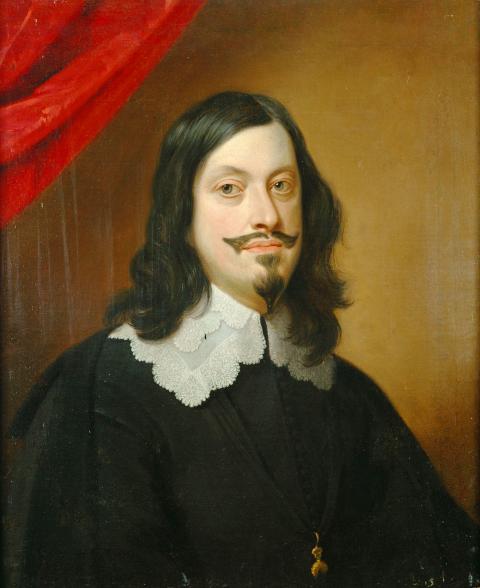As the name implies, a suite is a collection of short, stylistically different dances. They were a very popular form of composition during the Baroque period. The French ordre and suite and the Italian partite are just different words meaning the same thing.
In previous Bilingual Music articles we have seen how certain French Baroque composers would append unique — and often inscrutable — titles to individual dances within the suite. Yet, the music behind these mysterious titles actually has a set logic and sequence. That is, they would start with an allemande, followed by a courante, then a sarabande and perhaps a gavotte, and conclude with a gigue.
The German Baroque composer Johann Jakob Froberger (1616-1667) is generally regarded as the person who established the accepted sequence of the suite. The manuscripts he presented to the Holy Roman Emperor Ferdinand III have been preserved, and they became the model for later composers to follow.

Photo: Wikimedia Commons
照片:維基共享資源
Suites generally commence with a moderate tempo allemande (originally from “Allemagne,” the French word for Germany), providing a solemn opening to the music. This is followed by a faster tempo triple-meter courante, the name coming from the Italian word for “running,” as in flowing currents. The music then slows down to the moderate pace of the sarabande, a dance originating in the Spanish colonies in South America, a lively and energetic musical style that was tamed when brought across to Europe and transformed into the adagio dances popular in European court music. The gigue, a lively folk dance often used to end the suite with a final flourish, originated from the Irish jig imported to Europe in the mid-17th century before court composers gradually wove a contrapuntal texture into it.
While Baroque composers inherited Froberger’s order, they also introduced other dance styles, known as galanteries, which included elegant, lighter minuets and agile double-time French bourree and gavotte, as well as the chaconne and passacaglia, which were used for variations and later used by Johann Sebastian Bach, among others, to create their masterpieces.
(Translated by Paul Cooper)
巴洛克音樂中的「組曲」,顧名思義是由數首風格殊異的簡短舞曲組成,曾經是該時期最受歡迎的作品類型。法文「ordre」、「suite」,或義大利文「partite」其實指的都是「組曲」。
在日前的專欄中,我們知道法國巴洛克作曲家會為組曲中的各首短舞曲冠上獨特──又經常讓人摸不著頭緒──的神秘小標題。然而,這些標題背後的音樂本身仍然有著一定的規律和順序:通常以德國舞曲開頭,接著是庫朗舞曲,再依序演奏薩拉邦德舞曲、嘉禾舞曲等,最後以吉格舞曲結尾。
德國的巴洛克作曲家約翰‧雅各‧弗洛貝爾格(西元一六一六~一六六七)今日咸認為是「組曲」順序的奠基者,他致贈給神聖羅馬帝國皇帝斐迪南三世的手稿都被完整地保存下來,進而成為日後作曲家的創作典範。
組曲通常由速度溫和且偏慢的「德國舞曲」(音譯為阿勒曼德,源自於法文中的「德國」一字)展開整部作品,彷彿莊嚴的進場音樂。隨後接入三拍子的「庫朗舞曲」,速度極快,就像是該字的義大利文來源,呈現出水流的奔馳感。音樂隨後速度放慢,轉入溫柔和緩的「薩拉邦德舞曲」。這類音樂最初源自於西班牙在南美洲的殖民地,生動活潑的音樂風格在傳回歐洲大陸後遭到馴化,成為宮廷音樂中常見的慢板舞曲。充滿活力而富有民俗風味的「吉格舞曲」源自於愛爾蘭,在十七世紀中期傳入歐洲大陸,在宮廷作曲家們的筆下逐漸加入對位的音樂織理,通常被用來作為組曲的華麗壓軸。
在承繼弗洛貝爾格奠定的組曲結構之外,巴洛克作曲家亦會視情況與個人喜好加入其他的舞曲類型,稱為「組曲」內的「華麗曲」(galanteries),這些「可供選配」的音樂包括了優雅又不失輕盈的小步舞曲、輕快的二拍子法國「布雷舞曲」、「嘉禾舞曲」,以及「夏康舞曲」和「帕薩卡利亞舞曲」。具有變奏功能的後兩者,日後更成為包括巴赫等許多作曲家譜下扛鼎之作的載體。
(台北時報章厚明撰)

A: Finally! Cantopop superstar Andy Lau is touring Taipei starting tonight. B: Yeah, he is set to perform at the Taipei Arena for four nights. A: It seems like he is still energetic on stage even at the age of 63. B: Lau, Jacky Cheung, Leon Lai and Arron Kwok are dubbed Hong Kong’s “Four Heavenly Kings.” A: Hopefully, the four “kings” can visit Taiwan more often. A: 終於啊!香港天王劉德華今晚起將在台北開唱。 B: 他預計在台北小巨蛋,一連熱唱4天! A: 看來劉天王雖然63歲了,在舞台上還是一尾活龍。 B: 他和張學友、黎明、郭富城還被稱為香港「四大天王」。 A: 希望天王們以後能更常來台灣。 (By Eddy Chang, Taipei Times/台北時報張聖恩)

A: Originally, supergroup Mayday was also going to launch four charity concerts starting today. B: I know, they were trying to boost Hualien’s tourism industry. A: And all 14 artists from B’in Music were going to join the free concerts. B: But they just announced all shows will be postponed due to Typhoon Kong-Rey. A: Well, safety first. A: 原本今天起,天團五月天的公益演唱會也將開跑。 B: 我知道,主要是為了振興花蓮的觀光業。 A: 「相信音樂」旗下14組歌手,聽說這次都會共襄盛舉。 B: 結果主辦單位宣布所有演出因颱風康芮延期。 A: 嗯安全至上吧。 (By Eddy Chang, Taipei Times/台北時報張聖恩)

For people with hearing loss, clear communication can seem like a distant dream. However, advancements in technology are __1__ this barrier. TranscribeGlass, a wearable device, can translate spoken words into text displayed on a transparent screen directly in the user’s field of vision. This innovation enables people with hearing disabilities to fully engage in conversations. Assistive technology like captioning is an important means of communication for people with hearing loss. Captioning software on cellphones can be a helpful option, but it has limitations. Many users often find themselves __2__ to constantly glance down at the phone screen, which disrupts eye contact

Continued from yesterday(延續自昨日) https://www.taipeitimes.com/News/lang __4__ several devices offer real-time captions for the hearing impaired, TranscribeGlass distinguishes itself with its advanced functionality and user-friendliness. Traditional real-time captioning solutions can restrict both users and speakers by requiring speakers to stay close to a microphone. TranscribeGlass, on the other hand, can ensure clear communication even in challenging acoustic settings because it can __5__ audio from a distance, even from across a lecture hall. With TranscribeGlass, clear and effortless communication is finally within reach. 雖然有多款設備為聽障人士提供即時字幕,但TranscribeGlass以其先進的功能和好用性脫穎而出。傳統的即時字幕解決方案會需要說話者靠近麥克風,限制了使用者和說話者。相比之下,即使在具有挑戰性的聲音環境中,TranscribeGlass也可以確保清晰的溝通,因為其可接收到遠處的音訊,甚至可以從演講廳的另一邊接收到音訊。有了TranscribeGlass,清晰且輕鬆的溝通終於觸手可及。 What Did You Learn? 1. (A) invading (B) sustaining (C) eliminating (D) triggering 2. (A)